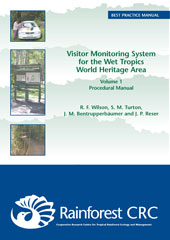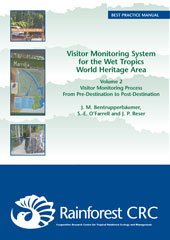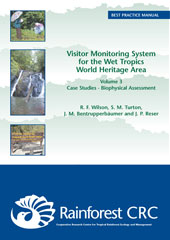 |
|||||
 |
Back to Research Report Series |
||||
| Report
No. 33 Visitor Monitoring System for the Wet Tropics World Heritage Area Three Volume Best Practice Manual ISBN 0 86443 741 2 (Set of Volumes 1, 2 and 3) Volume 1 Procedural Manual ISBN 0 86443 742 0 R. F. Wilson, S. M. Turton, J. M. Bentrupperbäumer and J. P. Reser Volume 2 Visitor Monitoring Process: From Pre-Destination to Post-Destination ISBN 0 86443 743 9 J. M. Bentrupperbäumer, S.-E. O'Farrell and J. P. Reser Volume 3 Case Studies: Biophysical Assessment ISBN 0 86443 744 7 R. F. Wilson, S. M. Turton, J. M. Bentrupperbäumer and J. P. Reser |
 |
||||

|
|||||
| Extract
from Executive Summary (Introduction) Australia's Wet Tropics World Heritage Area (WTWHA) is of international significance. It is the duty of the Australian community to ensure its special values are protected, conserved, presented and rehabilitated for future generations. In order to meet these obligations it has been recognised that the WTWHA requires a visitor monitoring system that incorporates regional and site-level monitoring and involves all levels of users, commercial and free and independent travellers, and managers. The Wet Tropics are an internationally acclaimed visitor destination. In 1998, there were over two hundred commercial tour operators with permits to operate within the Wet Tropics, most of who were operating in far north Queensland within the WTWHA. Visitors to the WTWHA sites also include domestic travellers and the local community. A survey, conducted in 1998 by Tourism Queensland, found domestic travellers account for more than eighty percent of visitors to Queensland. Direct use of the WTWHA by tourists is estimated to generate over $179 million annually, which is a significant contribution to the local and regional economy. There are over 180 sites being used by visitors to the WTWHA, of which 94 have associated infrastructure. This is a significant number of sites. Visitation is increasing to WTWHA sites and this requires careful management if it is to be sustainable. Human presence in any natural environment results in some level of disturbance and these impacts require monitoring. This Best Practice Manual consists of four sections, separated into three volumes. Section 1 (Volume 1) details how the components of the Visitor Monitoring System (VMS) link to provide useful information for visitor management. It also shows how this VMS links with other Systems at a national, state and regional level and how it is complemented by other research and survey activities within the Rainforest CRC. Section 2 (Volume 1) presents the protocols, proformas and methods used to monitor visitation and use, and directions for how the VMS might be enhanced with additional data from other sources in the future. Section 3 (Volume 2) details how the VMS may be linked with pre- and post-destination planning and other components of the travel sequence. Section 4 (Volume 3) comprises four case studies used to develop and trial the VMS. Download files are PDF documents that are designed to be printed using the duplex feature on your printer (i.e. double-sided) |
|||||

|
|||||
| Back to top | |||||
 |
|||||